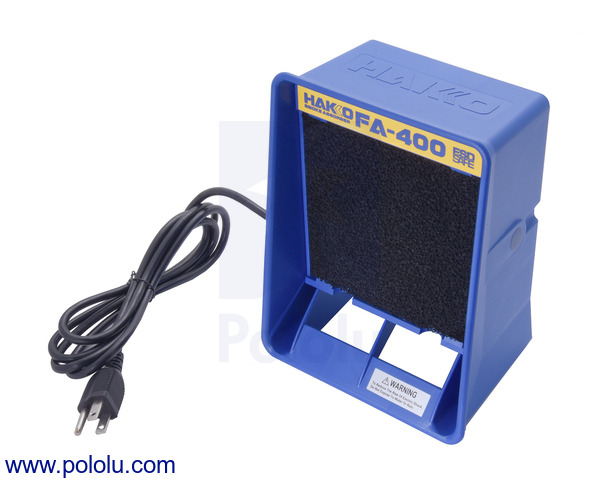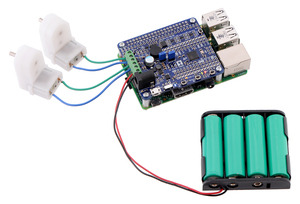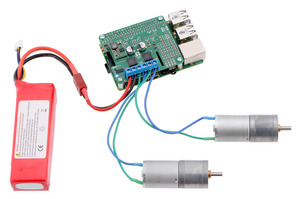Pololu Blog » User Profile: Ryan » Posts by Ryan »
Posts by Ryan (Page 6)
You are currently viewing a selection of posts from the Pololu Blog. You can also view all the posts.
Popular tags: community projects new products raspberry pi arduino more…
Analog PID line follower
In his blog post, Will Moore shows off his sleek line follower that uses an analog circuit for the PID control. The circuit is made from passive components and operational amplifiers, and the PID constants can be tuned with the potentiometers on the top. The build uses a pair of Pololu 50:1 micro metal gearmotors and motor brackets.
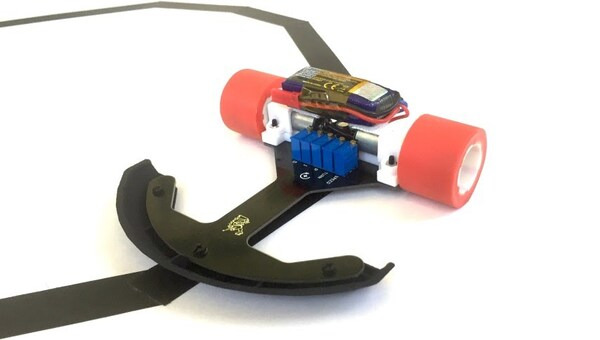 |
For more details, including schematics, performance analysis, and an additional video, see the blog post.
Mission Pinball Framework supports Maestro Servo Controllers
The Mission Pinball Framework is open-source software for running physical pinball machines. It can be used to control a re-themed pinball machine or a completely custom one. The framework supports using Pololu Maestro USB servo controllers to control RC hobby servos to create interesting pinball mechanisms. More details on using the Maestros with the pinball framework are available in their detailed documentation.
MINTomat: an over-complicated bubble gum dispenser
MINTomat lets you operate two robot arms and a wirelessly controlled custom robot based on a Pololu Zumo chassis to dispense a gumball in an roundabout way. Their custom Zumo board is controlled with FreeRTOS on an NXP ARM Cortex-M4F, and uses a Nordic Semiconductor nRF24L01+ 2.4 GHz transceiver for wireless communication with other parts of the system. A few Pololu VL6180X time-of-flight distance sensor carriers are used for obstacle detection and navigation. The cabinet is illuminated with LED strips. A detailed build log is available at this blog post.
Just Keep Swimming: a goldfish-steered mobile fish tank
 |
During Build18 2017, “an annual engineering festival held by the Electrical and Computer Engineering department at Carnegie Mellon University and run by students”, a team of CMU students presented a goldfish-steered mobile fish tank that allows the goldfish to decide where to drive. The robot is controlled by a Raspberry Pi and uses some Pololu parts listed below. They posted a video of the robot on Facebook, and their project webpage has a description and a parts list.
Robotic snow plow
Robert Cowan, former host of the SparkFun Friday new product videos, has made a series of videos on his YouTube channel about building a robotic snow plow. The videos includes the parts he uses, design decisions, and iterations he made along the way. Many components of the robot are reused wheelchair parts. In part 2, he uses a Pololu Simple Motor Controller 18v7 to control the linear actuator for the plow’s tilt mechanism from an RC transmitter.
Pololu and LVBots CES Open House 2017
Are you attending CES or in Las Vegas this Friday evening? You can join Pololu and LVBots on January 6 any time from 5 p.m. to 8 p.m. for CES Open House 2017! Like last year, LVBots members will be showcasing their robotics and electronics creations, Pololu will be giving tours of our manufacturing and other operations, and you can present your company or your projects. We will provide pizza. Registration and other details are on the LVBots Meetup page.
New product: T1-3/4 (5mm) RGB LED with Diffused Lens (5-pack)
We are now selling T1-3/4 (5mm) common anode RGB LEDs! These multi-color LEDs contain red, green, and blue (RGB) elements that can be mixed to produce different colors. The three color elements share a common anode and are encased in a diffused white lens that blends the colors and widens the viewing angle. This product is a pack of five (5) RGB LEDs.
 |
These LEDs replace the RGB LEDs with a common cathode that we used to sell. The common-anode setup of the new ones is nice because you can drive the LEDs with a low-voltage microcontroller I/O pin in an open-drain configuration (provided the pins can handle the current and are tolerant of the LED supply voltage). If you need to build your own drive circuit, you just need one low-side transistor per LED.
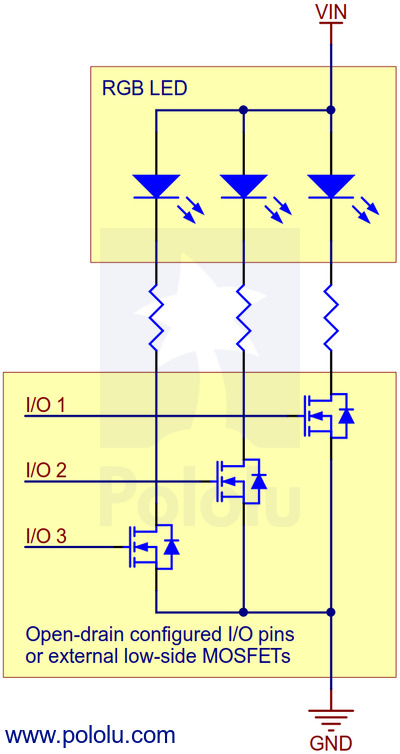 |
Here are some other posts on our blog about LEDs:
New product: Hakko FA-400 Smoke Absorber
We are now offering the Hakko FA-400 Smoke Absorber. The Hakko FA-400 is a benchtop smoke absorber for removing smoke generated by soldering. It has an easily-replaceable activated-carbon filter and a sturdy ESD-safe housing that can be oriented horizontally or vertically.
New product: Raspberry Pi 3 Model B
We are now offering the Raspberry Pi 3 Model B. The Raspberry Pi is a popular credit card-sized computer that can run ARM Linux distributions. As the successor to the Raspberry Pi 2 Model B, the Pi 3 has a more powerful processor and adds wireless connectivity. Here are the specific improvements:
- 1.2 GHz 64-bit quad-core ARMv8 CPU
- 802.11n Wireless LAN
- Bluetooth 4.1
- Bluetooth Low Energy (BLE)
Along with these improvements, the Raspberry Pi 3 maintains compatibility with and the form factor of the previous Pi 2 (and Pi 1 Model B+). With its 0.1″-spaced GPIO header and small size, the Raspberry Pi also works as a programmable controller in a wide variety of robotics and electronics applications. It can also be combined with our A-Star 32U4 Robot Controller LV with Raspberry Pi Bridge to make a great controller for a small robot. We also carry a selection of Raspberry Pi expansion boards.
|
|
This comparison chart can help in selecting the right Raspberry Pi for your project:
 Raspberry Pi Model A+ 512MB |
 Raspberry Pi Model B+ |
 Raspberry Pi 2 Model B |
 Raspberry Pi 3 Model B |
 Raspberry Pi 3 Model B+ |
|
|---|---|---|---|---|---|
| CPU: | BCM2835 | BCM2836 | BCM2837 | BCM2837B0 | |
| CPU cores: | 1 | 4 | |||
| CPU speed: | 700 MHz | 900 MHz | 1.2 GHz | 1.4 GHz | |
| RAM: | 512 MB | 512 MB | 1 GB | ||
| Ethernet: | No | Yes | |||
| WiFi: | No | 2.4 GHz 802.11n | 2.4 GHz 5 GHz 802.11b/g/n/ac | ||
| Bluetooth: | No | 4.1 | 4.2 | ||
| Bluetooth Low Energy: | No | Yes | |||
| HDMI: | Yes | ||||
| Analog video: | Yes1 | ||||
| SD socket: | microSD | ||||
| Onboard regulators: | switching | ||||
| Expansion header pins: | 40 | ||||
| USB ports: | 1 | 4 | |||
| Mounting holes: | 4 | ||||
| Dimensions2: | 2.5″ × 2.2″ × 0.47″ | 3.35″ × 2.2″ × 0.8″ | |||
| Weight3: | 23 g | 42 g | 50 g | ||
1 Audio and analog video provided by a single four-pole 3.5 mm jack. This 3.5 mm jack also has its own dedicated low-noise power supply for improved audio.
2 Length and width measurements are for the PCB only; several of the connectors extend past the edge of the board.
3 Weight does not include microSD cards.
New product: MP3 Trigger V24
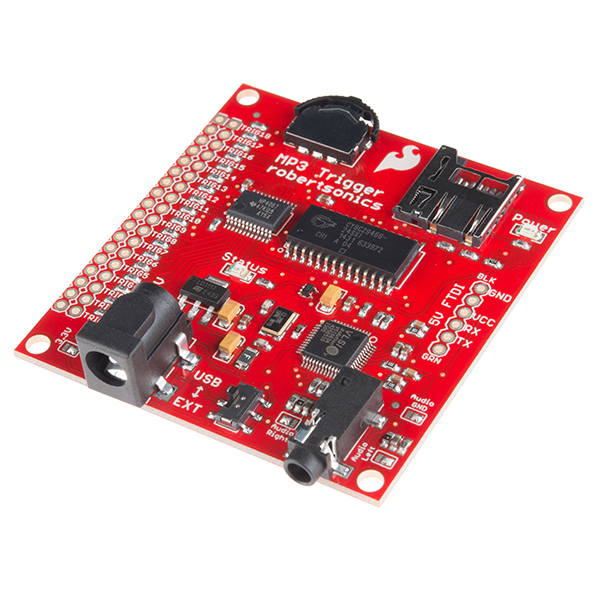 |
The updated MP3 Trigger V24 from SparkFun is now for sale. This new version features improved firmware that can read a configuration file from the SD card, making it much easier to use without a microcontroller. We posted previously about a project using an A-Star 32U4 and an MP3 Trigger to make a Scary shaking tombstone. The MP3 trigger also pairs nicely with the Maestro Servo Controllers because you can use a Maestro servo controller’s scripting capability to trigger sounds to play in sync with motion. You can see examples of how people are using them on our forum here and here.
















